Special Report
The Poorest County in Every State

Published:
Last Updated:

Incomes vary considerably across the country as well as within states. The income gaps between each state’s richest county and poorest county also vary considerably, with some states more equal than others. Still the states’ poorest counties have much in common, and with one exception, median household incomes in all are lower than the national median income. The only exception is the poorest county in Connecticut, where the typical household earns $59,392 annually, more than the $53,889 income of the typical American household.
Loudon County, Virginia is the richest county in the United States, with a median household income of $123,453 a year. McCreary, Kentucky is the poorest U.S. county, with a median household income of $19,328 a year.
[in-text-ad]
To highlight how income levels vary geographically, 24/7 Wall St. reviewed annual median household incomes in every county, in every state.
Click here to see the poorest counties in every state.
Click here to see the richest counties in every state.
Income is one of the principal determinants of well-being, and when income falls below a certain threshold, financial hardship that can affect many areas of life becomes considerably more likely. In low-income areas, poverty is far more common than elsewhere, especially when compared to other, wealthier areas in the state. In all but nine states, the poorest county’s poverty rate is at least double that of the richest county. And in most states, residents of the poorest county are more than three times as likely than residents of the richest county to live in poverty.
Educational attainment is one of the best predictors of future income levels. Compared with state measures and those of nearby rich areas, low-income counties tend to have lower college attainment rates. In only four cases, adults living in a state’s poorest county are more likely to have gone to college than adults nationwide: Madison, Idaho; Jackson, Illinois; Berkshire, Massachusetts; and Whitman, Washington. Incidentally, major colleges or universities operate in the vicinity of these four counties, and in each area there are above average shares of residents currently enrolled in college.
Education levels in rich areas exceed those in poor areas in every state except for Washington and Montana. In a majority of states, the highest income county reports a college attainment rate at least double that of the poorest county.
County population and density also appear related to income levels, as most states’ rich counties are considerably more populated and more dense than the poor counties. Of the 50 low-income counties on this list, all but eight are more sparsely populated than their state’s respective richest county.
To identify the poorest county in each state, 24/7 Wall St. reviewed median annual household incomes from the U.S. Census Bureau’s American Community Survey (ACS). In order to be considered, counties or county-equivalents had to have a population of at least 10,000 people. We also reviewed in each county the percentage of adults who have completed at least high school and at least college, as well as poverty rates, the percentage of owner-occupied housing units (the homeownership rate), median home values, and the percentage of area adults who identify as American Indian or Alaska Native from the ACS. All ACS data are five-year averages for 2011-2015. Unemployment rates are from the Bureau of Labor Statistics and are for November 2016, the most recently available period. Population density came from the Census Bureau’s 2010 decennial census.
These are the poorest counties in each state.
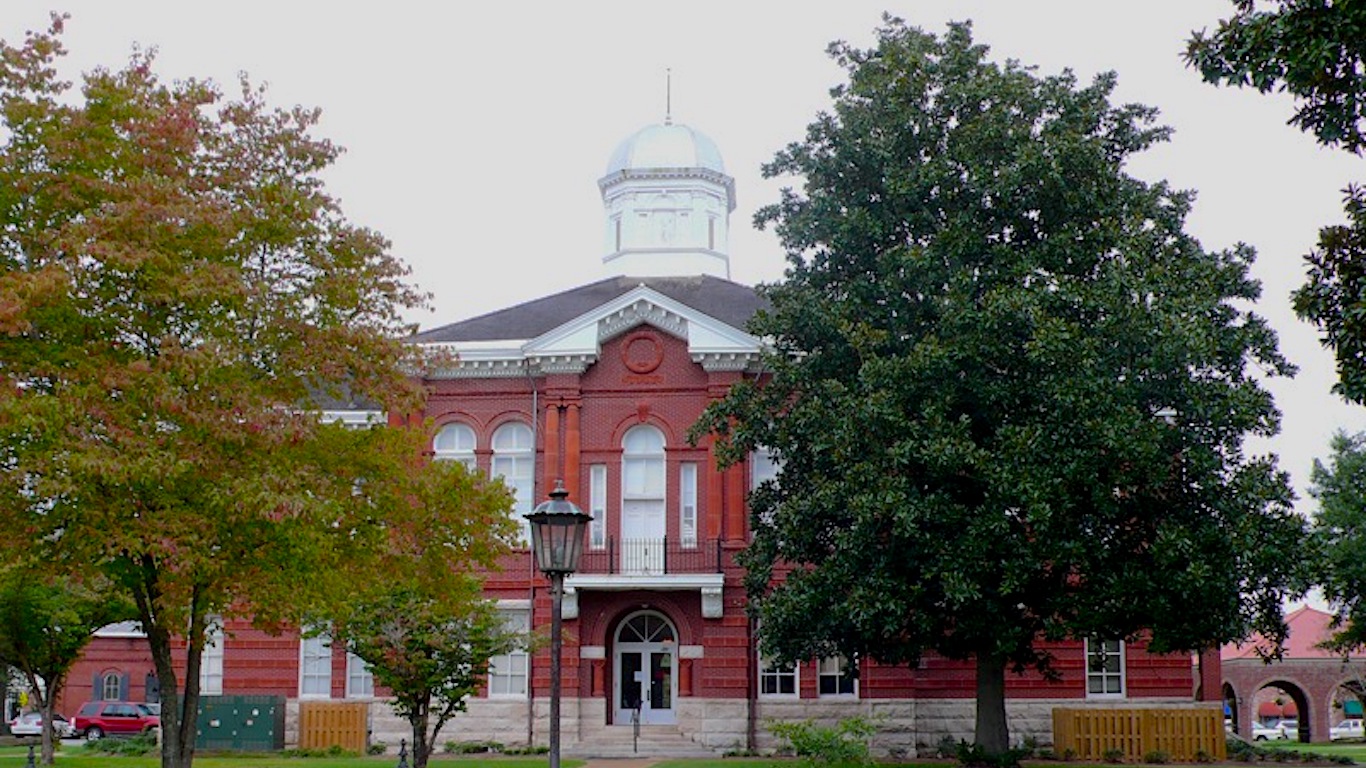
1. Sumter, Alabama
> County median household income: $19,501
> State median household income: $43,623
> Poverty rate: 42.7%
> Nov. unemployment: 7.3%
The typical household in Sumter earns less than $20,000 annually — the lowest of any county in Alabama and nearly the lowest of the over 2,000 U.S. counties reviewed. For reference, the federal poverty threshold for a household of three is just over $20,000. In Sumter, 42.7% of people live in poverty compared to 18.8% of residents statewide and 15.5% of Americans nationwide.
[in-text-ad]
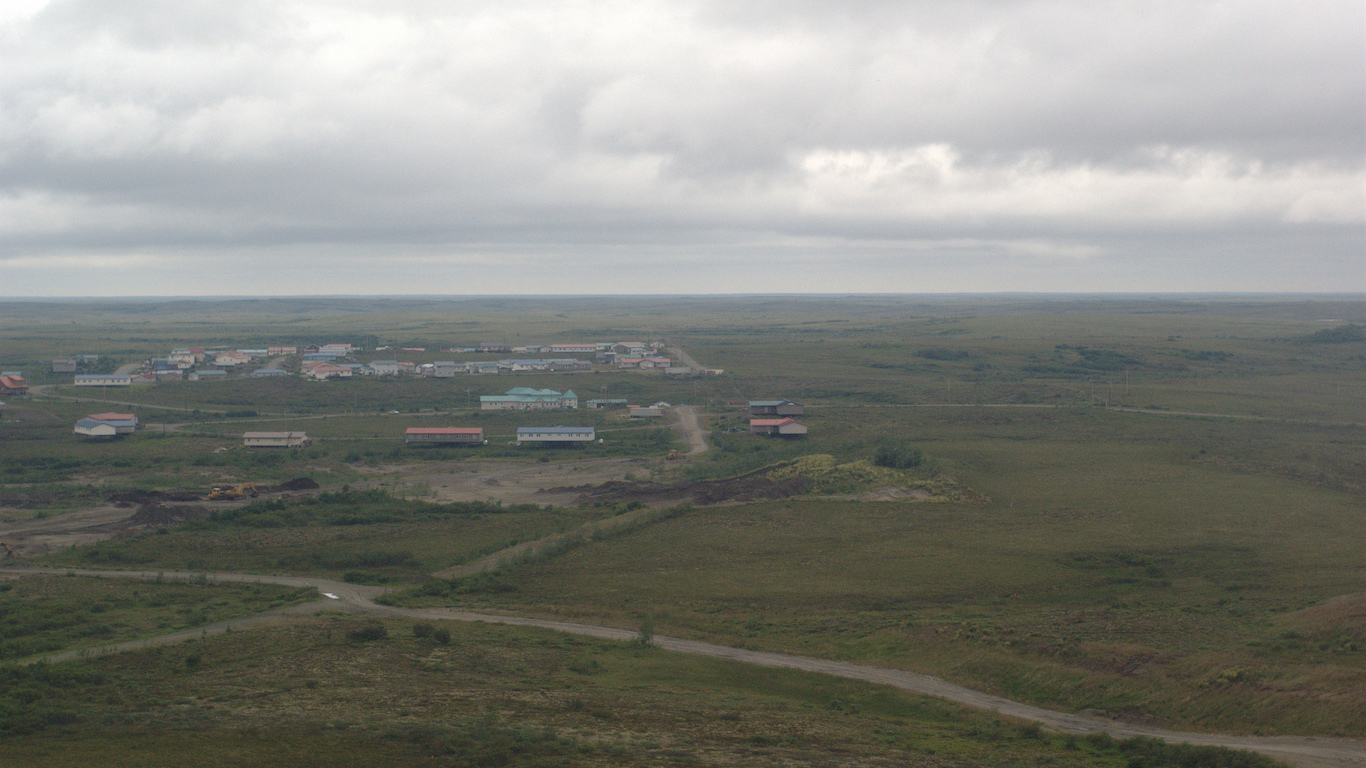
2. Bethel Census Area, Alaska
> County median household income: $51,012
> State median household income: $72,515
> Poverty rate: 25.2%
> Nov. unemployment: 12.1%
Alaska has the second highest median household income of all states. Even in the state’s poorest region, the Bethel Census Area, the typical household income is $51,012, which is only slightly below the national median income. The area comprises much of the territory of the state occupied by the Yupik people. More than 80% of the census area’s population consists of Native Americans, a demographic that has historically suffered from poverty.

3. Apache, Arizona
> County median household income: $31,757
> State median household income: $50,255
> Poverty rate: 36.6%
> Nov. unemployment: 10.2%
Native Americans are some of the nation’s most economically disadvantaged people, and Apache — the poorest county in Arizona and one of the poorest in the country — is a case in point. Native Americans comprise over 70% of the county’s population. The Navajo Nation, the nation’s largest Native American tribe, spans over half of Apache County’s land area.
At 36.6%, Apache’s poverty rate is more than double the state poverty rate of 18.2%, itself eighth highest compared with other states.

4. Phillips, Arkansas
> County median household income: $26,844
> State median household income: $41,371
> Poverty rate: 34.1%
> Nov. unemployment: 5.1%
The typical household in Phillips, Arkansas earns just $26,844 a year, almost $30,000 less than in Benton, the state’s wealthiest county. Educational attainment is one of the strongest determinants of regional income, and Phillips’ residents are much less likely to have the education levels needed to earn a higher than average income. Nearly one in four Phillips County adults lacks a high school diploma, and barely one in 10 have a bachelor’s degree, each among the worst attainment rates of any county in the country.
[in-text-ad-2]
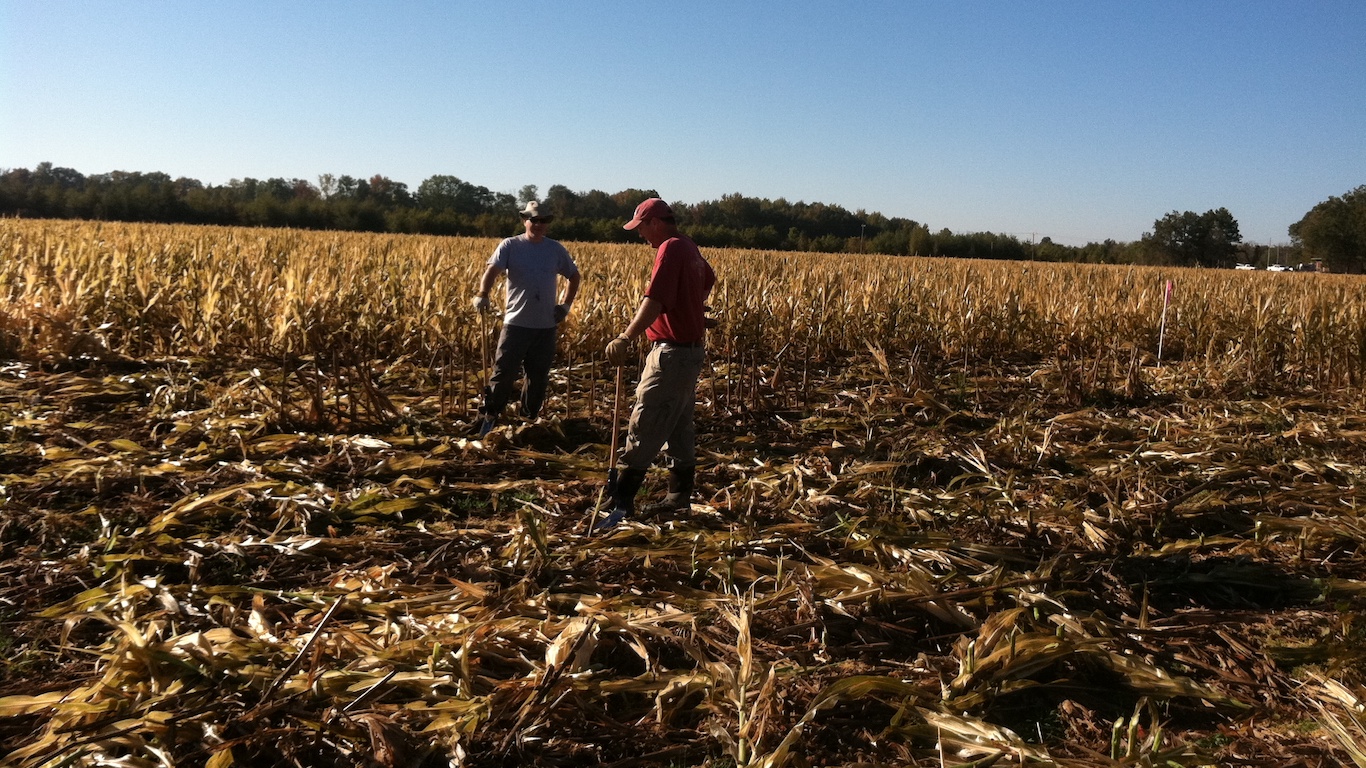
5. Trinity, California
> County median household income: $34,974
> State median household income: $61,818
> Poverty rate: 19.5%
> Nov. unemployment: 6.4%
Trinity, a rural county in Northern California, is the poorest in the state. The typical area household earns only about $35,000 a year, well below the median income statewide of $61,818 a year. A relatively weak job market likely contributes to financial hardship in the county. Trinity’s 6.4% unemployment rate is higher than the statewide unemployment rate of 5.0%. Nearly one in five county residents live in poverty, larger than the state’s 16.3% poverty rate.

6. Otero, Colorado
> County median household income: $32,311
> State median household income: $60,629
> Poverty rate: 24.3%
> Nov. unemployment: 3.8%
The typical household in Otero, Colorado, earns just $32,311 annually, well below the median income of $60,629 for the state and about $61,000 less than the typical household in Douglas, the state’s wealthiest county. While 12.7% of Colorado and just 4% of Douglas residents live in poverty, Otero’s poverty rate is 24.3%. Rural populations tend to have lower incomes, and Otero is a sparsely populated county. There are just 14.9 residents per square mile in Otero, much less dense than across the United States, where there are 87.4 residents on average for each square mile.
[in-text-ad]
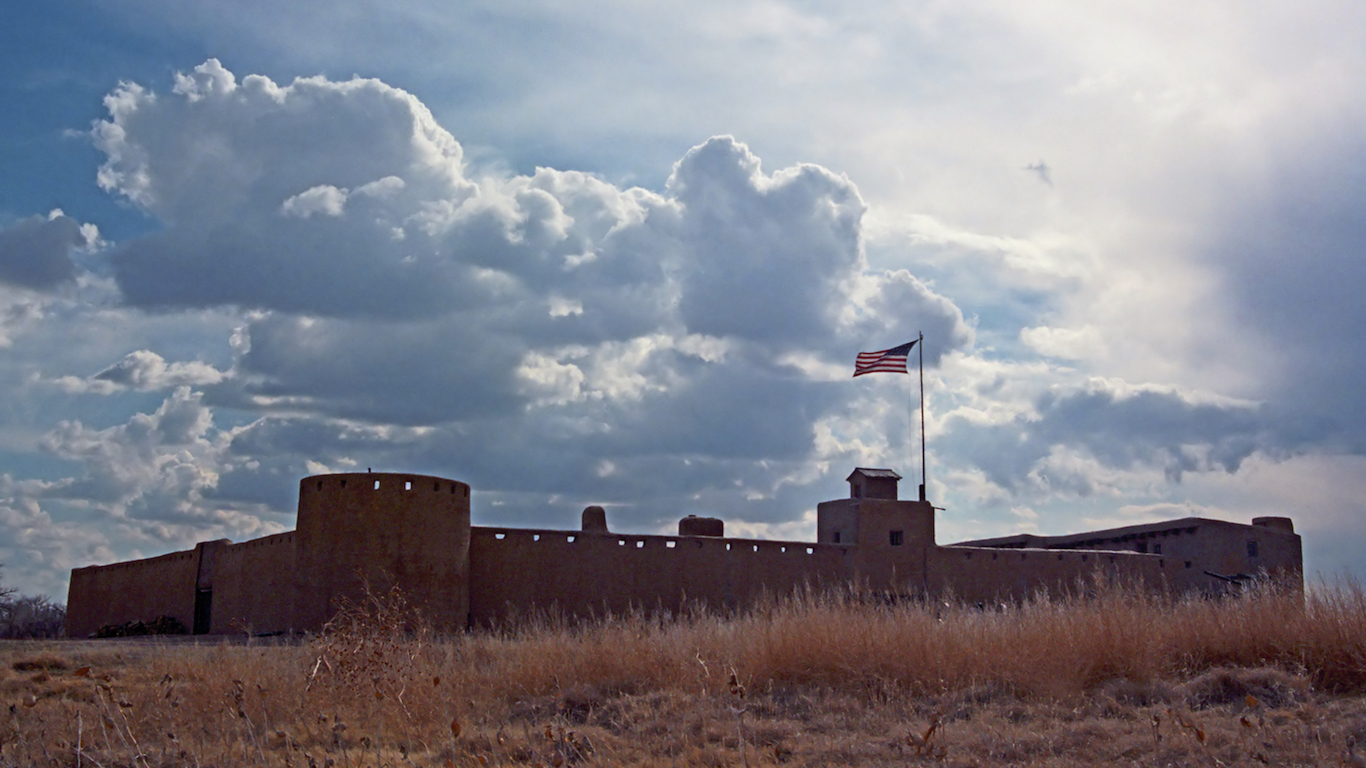
7. Windham, Connecticut
> County median household income: $59,392
> State median household income: $70,331
> Poverty rate: 10.7%
> Nov. unemployment: 3.9%
With a median household income of $70,331 a year, Connecticut is one of the wealthiest states in the country. Even Windham, the poorest county in the state, is relatively well-off financially compared to the nation. The typical household earns $59,392 a year, well above the national median income — Windham is the only county on this list where this is the case. Similarly, Windham’s poverty rate of 10.7% is far lower than in other relatively poor counties.
Lower incomes in Windham partially the result of lower-paying jobs. Higher educational attainment correlates with higher-skilled, higher-paying jobs. In Windham, only 23.1% of adults have at least a bachelor’s degree, a far lower share than the 37.6% of Connecticut adults.

8. Sussex, Delaware
> County median household income: $53,751
> State median household income: $60,509
> Poverty rate: 12.6%
> Nov. unemployment: 4.1%
Of the three Delaware counties with 10,000 or more residents, Sussex is the poorest. The typical county household earns $53,751 annually, just under the national median of $53,889 and well under the state median household income of $60,509. Still, people in Sussex, while poorer than Delaware residents as a whole, do not have nearly as low incomes as in many other areas on this list. For example, the county’s poverty rate of 12.6% is lower than the national rate of 15.5%. Also, the county’s unemployment rate of 4.1% is only slightly higher than the rate in Delaware’s richest county, and it is lower than the national jobless rate of 4.6%.
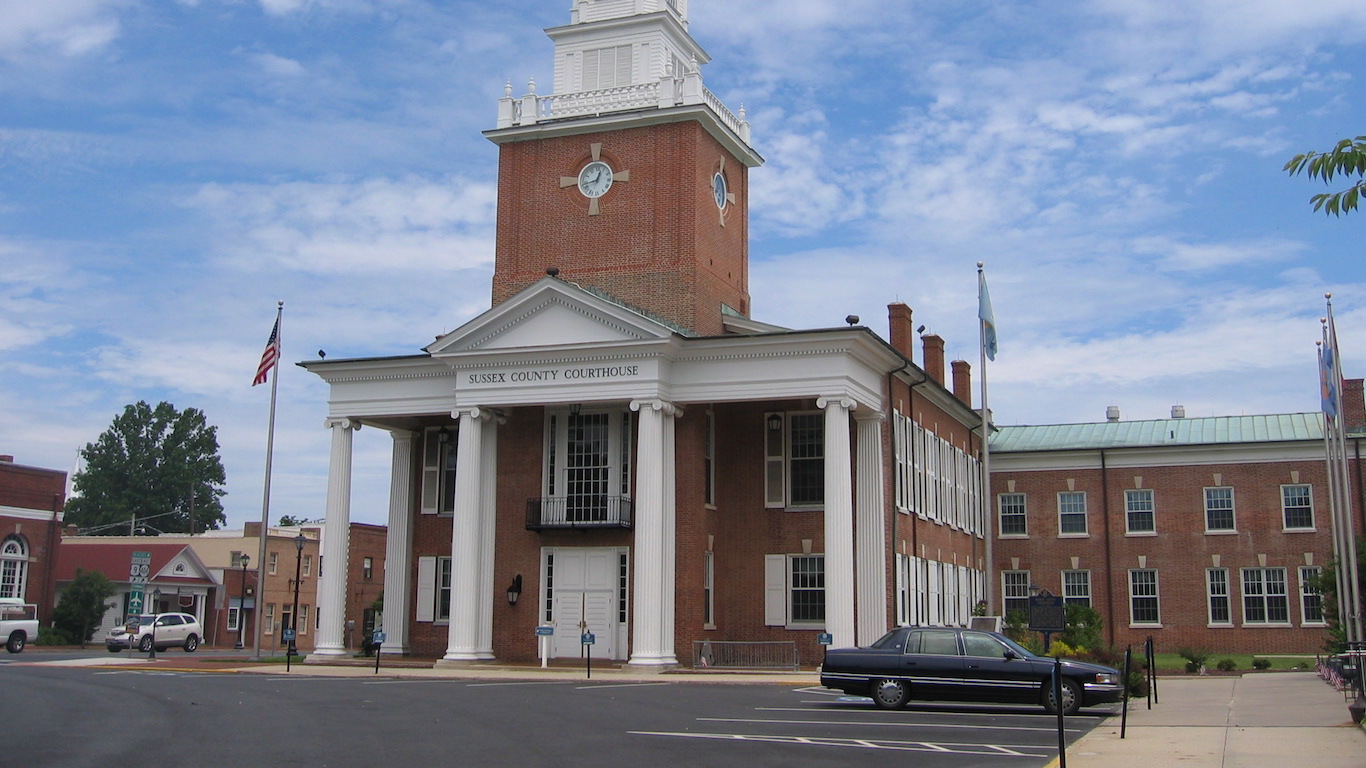
9. Putnam, Florida
> County median household income: $31,715
> State median household income: $47,507
> Poverty rate: 28.7%
> Nov. unemployment: 5.9%
Educational attainment is one of the strongest determinants of income levels in a population, and in parts of the country where fewer adults have completed high school or college incomes tend to be lower. This is clearly the case in Putnam, the state’s poorest county. Across the state, 86.9% of adults have at least a high school diploma, and 27.3% have a bachelor’s degree. Just 78.5% of adults in Putnam have a high school diploma, and only 11.8% have a bachelor’s degree.
[in-text-ad-2]
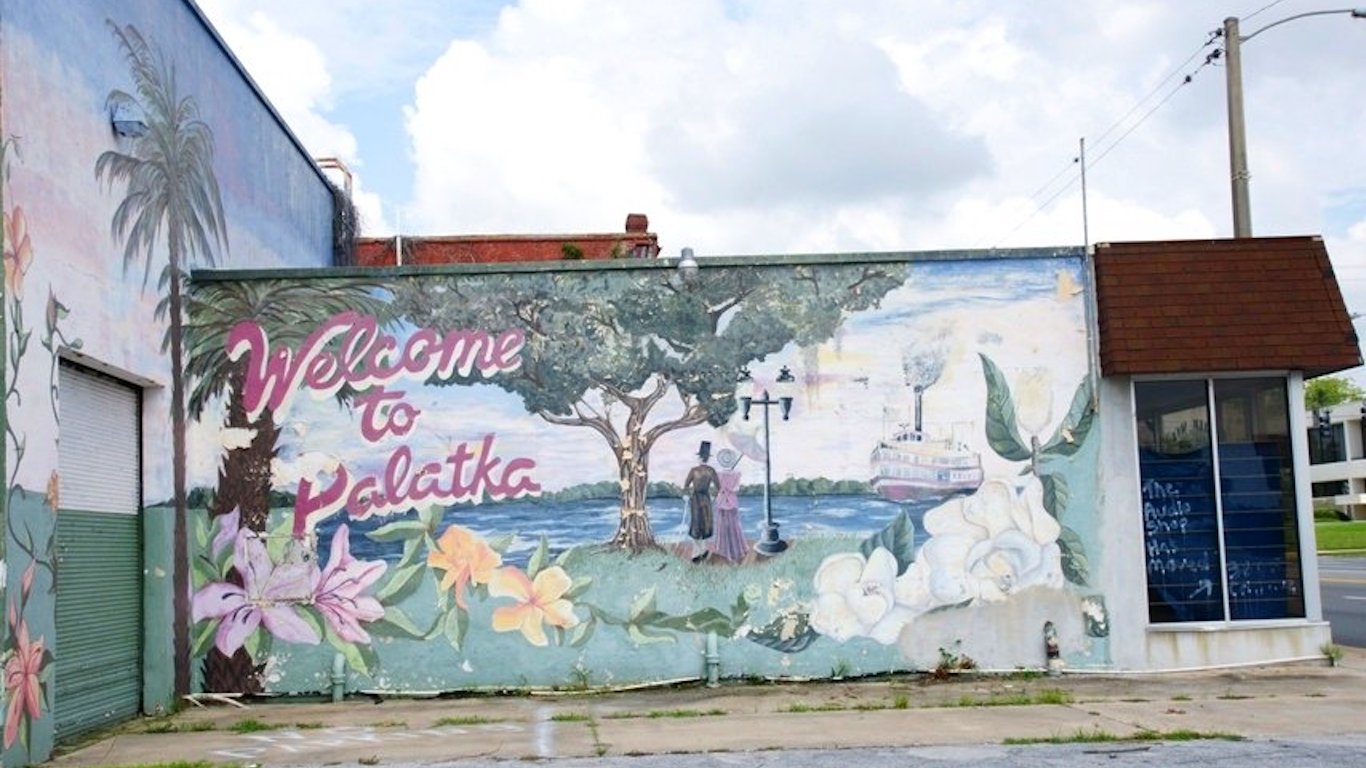
10. Telfair, Georgia
> County median household income: $26,449
> State median household income: $49,620
> Poverty rate: 28.5%
> Nov. unemployment: 8.8%
Economic conditions in Telfair, Georgia are poor. The typical area household earns only $26,449 annually, the lowest in the state and less than half the income the typical American household earns in a year. Low incomes in the area are underscored by rampant poverty. Approximately 29% of the county’s 16,400 residents live in poverty, almost double the nationwide poverty rate. For many working-age adults in Telfair, gainful employment is elusive. With an 8.8% unemployment rate, hundreds of Telfair residents who want to work are unable to do so.

11. Hawaii, Hawaii
> County median household income: $52,108
> State median household income: $69,515
> Poverty rate: 19.5%
> Nov. unemployment: 3.4%
Hawaii county is the poorest in a relatively wealthy state. The typical county household earns $52,108 a year, only slightly less than the typical American household income of $53,889. While income levels are only slightly below-average, financial hardship is far from uncommon. Countywide, 19.5% of the population is in poverty, well above the 11.2% statewide poverty rate and the 15.5% nationwide rate.
Unlike many of the poorest counties in other states, relatively few Hawaii County residents are struggling to find a job. In November, 3.4% of the area’s labor force was unemployed, well below the corresponding 4.6% national rate.
[in-text-ad]

12. Madison, Idaho
> County median household income: $32,233
> State median household income: $47,583
> Poverty rate: 35.7%
> Nov. unemployment: 2.3%
Extremely low homeownership is usually a sign of a very urban metropolitan area, or low incomes. Madison, Idaho’s poorest county, is certainly not an urban area — its population density of about 80 residents per square mile is slightly below the national population density. Yet, just 47.6% of Madison housing units are owned by their occupants, significantly lower than the state’s 68.9% homeownership rate. The county poverty rate of 35.7% is not just the highest in Idaho, but one of the highest in the nation.

13. Jackson, Illinois
> County median household income: $33,871
> State median household income: $57,574
> Poverty rate: 30.5%
> Nov. unemployment: 5.0%
Jackson has the lowest median household income of any county reviewed in Illinois. The typical household earns only $33,871 annually, versus the state median income of $57,574 and national median income of $53,889.
Homeownership can increase personal net worth, and ultimately improve economic well-being. However, homes in Jackson have far less value than homes across the state and the country. Countywide, the typical home is worth only $103,000, significantly lower than the typical home value across Illinois of about $173,800.
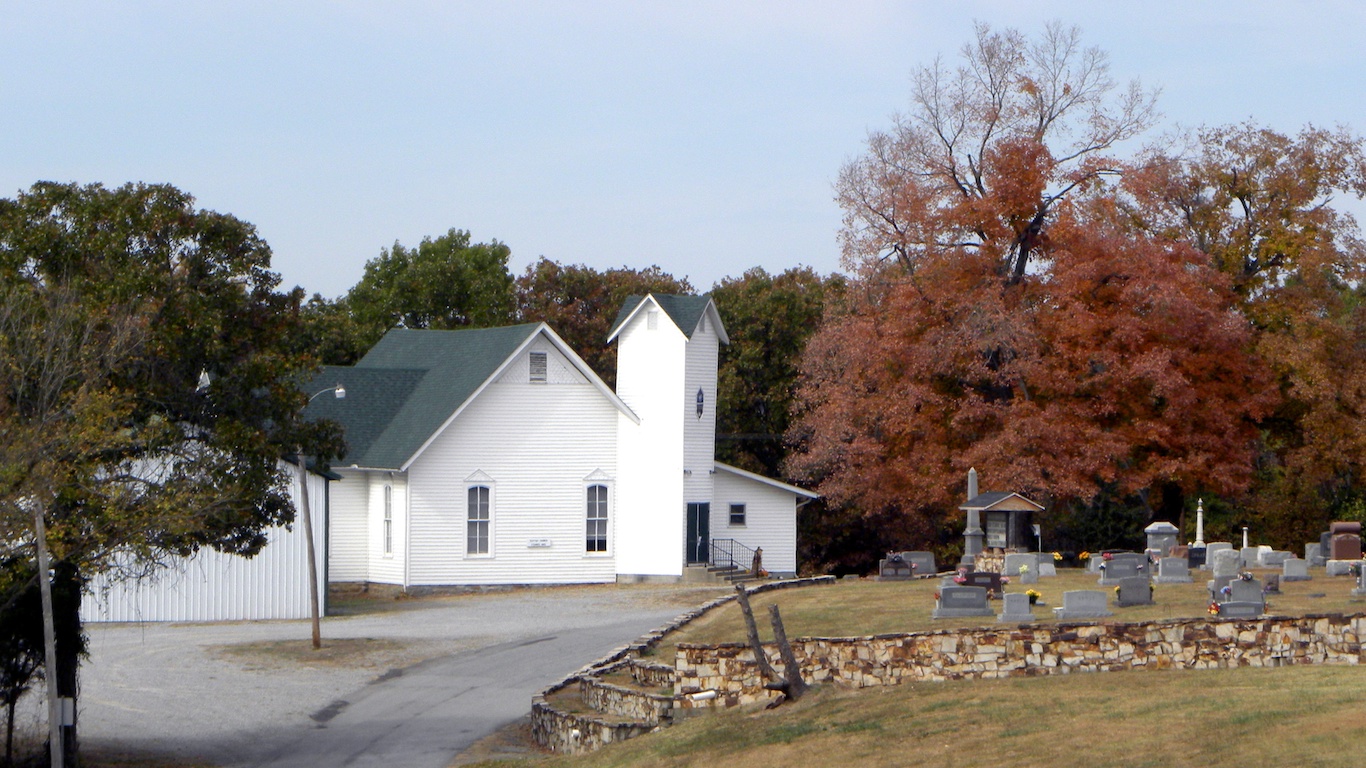
14. Blackford, Indiana
> County median household income: $38,190
> State median household income: $49,255
> Poverty rate: 14.0%
> Nov. unemployment: 4.8%
In Blackford, just 10% of adults have a college degree. By contrast, 30% of adults nationwide, 24% of adults statewide, and 56% of adults in Indiana’s richest county have at least a bachelor’s degree. Because college-educated adults tend to earn higher incomes than less educated adults, the low educational attainment in Blackford helps explain the county’s low income levels. The typical county household earns $38,190 annually, the lowest in the state. Compared with other low-income areas, however, Blackford’s poverty rate of 14.0% is exceptionally low.
[in-text-ad-2]
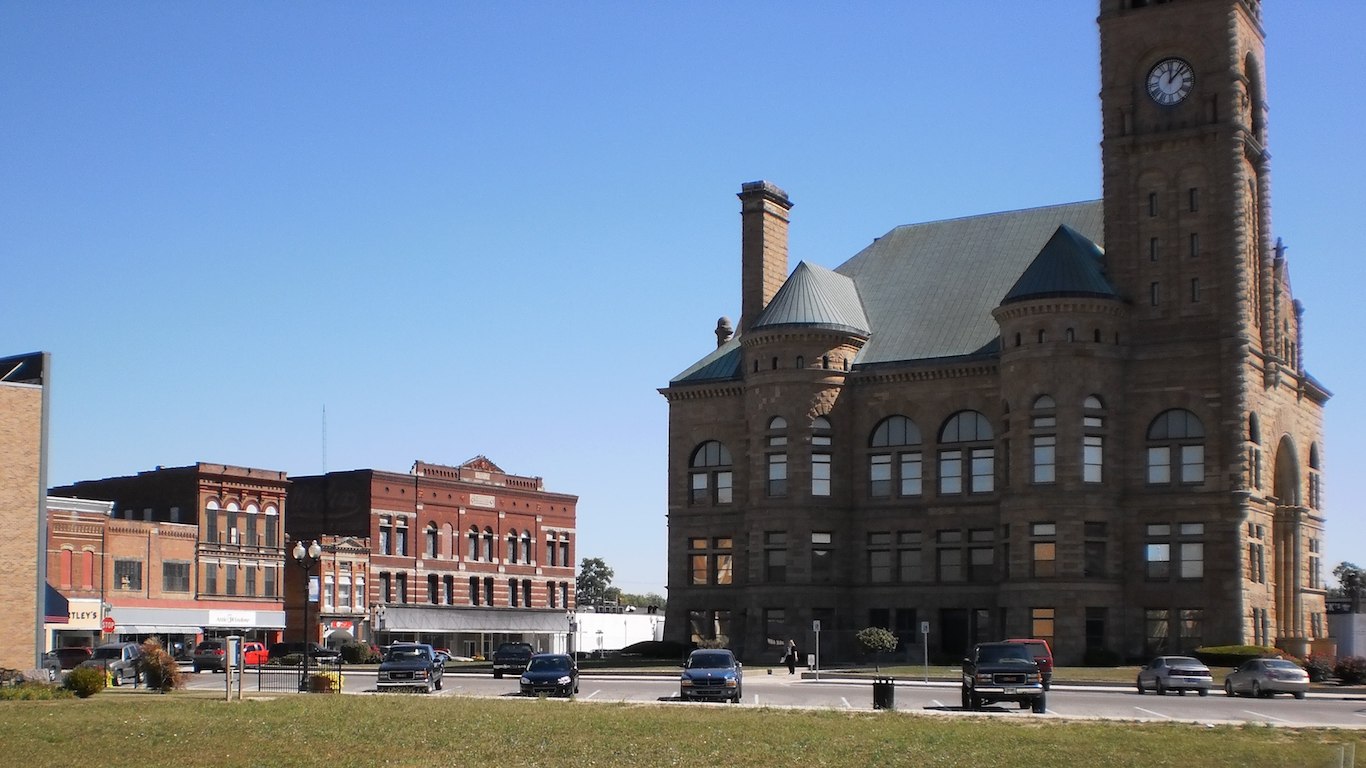
15. Appanoose, Iowa
> County median household income: $41,394
> State median household income: $53,183
> Poverty rate: 13.7%
> Nov. unemployment: 4.6%
Unlike the poorest counties in most states, poverty in Appanoose, while more common than across the state, is well below the national poverty rate of 15.5%. Low incomes are reflected in other economic measures for the county — low-income housing markets tend to have less valuable homes, for example. The homeownership rates in both Iowa’s poorest and richest counties are similar. However, the typical home in Appanoose is worth about $78,200, one of the lowest home values nationwide and more than $100,000 lower than the median home value in Dallas, Iowa’s richest county.

16. Crawford, Kansas
> County median household income: $36,534
> State median household income: $52,205
> Poverty rate: 22.0%
> Nov. unemployment: 4.4%
Crawford is Kansas’ poorest county, with a median household income of just $36,534 a year, close to $40,000 less than the median income in Johnson, the state’s wealthiest county. The counties’ incomes are reflected in their poverty rates. While 22% of Crawford’s population lives below the poverty line, only 6.2% of Johnson’s population does. Because home values tend to generally reflect the purchasing power of residents and the desirability of an area, poorer parts of the country tend to have less valuable property. In Crawford, the typical home is worth just $86,000, less than half the U.S. median home value of $178,600.
[in-text-ad]

17. McCreary, Kentucky
> County median household income: $19,328
> State median household income: $43,740
> Poverty rate: 41.0%
> Nov. unemployment: 5.8%
McCreary is the poorest county in Kentucky and the poorest in the United States. The typical area household earns only $19,328 a year, less than half the median income statewide. Low incomes across McCreary are closely tied to the county’s educational attainment rate. Only 7% of county adults have a bachelor’s degree, far less than the 30% of adults nationwide. Many area jobs likely do not require higher education degrees, common requirements of the nation’s high paying jobs. The low incomes in the area are underscored by the county’s 41% poverty rate, which is more than double the 15.5% national poverty rate.

18. Madison, Louisiana
> County median household income: $23,854
> State median household income: $45,047
> Poverty rate: 38.4%
> Nov. unemployment: 8.0%
Louisiana is a relatively poor state with a median household income of $45,047 a year, about $8,800 below the national median. Madison is extremely poor, even by state standards. The typical Madison household earns $23,854 annually, the lowest in the state and one of the lowest in the country. While 15.5% of Americans live below the poverty line, Madison’s poverty rate is 38.4%, the ninth highest of any U.S. county with at least 10,000 people.

19. Aroostook, Maine
> County median household income: $36,923
> State median household income: $49,331
> Poverty rate: 18.5%
> Nov. unemployment: 5.7%
Rural counties tend to have fewer job opportunities, particularly high-paying ones. Aroostook, where just 11 people live per square mile on average, is one such county. The low median household income in Aroostook, Maine’s poorest and northernmost county, is partially the product of a relatively weak job market. With a 5.7% unemployment rate, nearly 1,800 county workers are unable to find work. The typical county household earns just under $37,000 annually, well below the $49,331 statewide median income.
[in-text-ad-2]

20. Somerset, Maryland
> County median household income: $35,154
> State median household income: $74,551
> Poverty rate: 24.7%
> Nov. unemployment: 6.6%
With an annual median household income of $74,551, Maryland is the wealthiest state in the country. However, not all corners of the state are equally prosperous. In Somerset, the poorest county in the state by median household income, one in four residents live in poverty compared with about one in every 10 Maryland residents. For many area residents, financial hardship likely stems from a lack of available jobs. As of November last year, 6.6% of the county’s labor force was out of a job, or roughly 600 people. In comparison, only 4.1% of the Maryland labor force is out of a job and looking for work.

21. Berkshire, Massachusetts
> County median household income: $49,956
> State median household income: $68,563
> Poverty rate: 13.0%
> Nov. unemployment: 2.9%
Berkshire is the poorest county in one of the nation’s wealthiest states. The $50,000 median household income in the county is about $18,600 less than the median across Massachusetts, but only about $4,000 less than the median income nationwide. In many poor counties, a tough job market can partially explain the low median income. This is not the case in Berkshire, however. The county’s 2.9% unemployment rate is only slightly higher than the 2.6% statewide jobless rate, and far better than the 4.6% national unemployment rate.
[in-text-ad]

22. Lake, Michigan
> County median household income: $30,439
> State median household income: $49,576
> Poverty rate: 28.7%
> Nov. unemployment: 6.3%
In Lake, Michigan, the typical household earns only $30,439 a year, about $19,000 less than the typical household across the state. Approximately 29% of the county’s 11,400 resident live in poverty, a far higher share than the state and national poverty rates of 16.7% and 15.5%, respectively.
Low incomes in Lake are indicative of low-paying jobs that require little in the way of education. Fewer than 10% of area adults have a bachelor’s degree, a far smaller share than the roughly 30% of American adults.

23. Wadena, Minnesota
> County median household income: $41,906
> State median household income: $61,492
> Poverty rate: 16.4%
> Nov. unemployment: 4.5%
With a median household income of $61,492 a year, Minnesota is one of the richest states. While the high incomes are not perfectly distributed across the state, the median household income in the state’s poorest county, Wadena, is $41,906 a year, far from the lowest of all U.S. counties. Still, as is generally the case in low-income areas, Wadena residents are far less likely to have completed at least college than their statewide and nationwide peers. Of adults in the county, 12.7% have a bachelor’s degree, far lower than the state and national percentages of 33.7% and 29.8%.
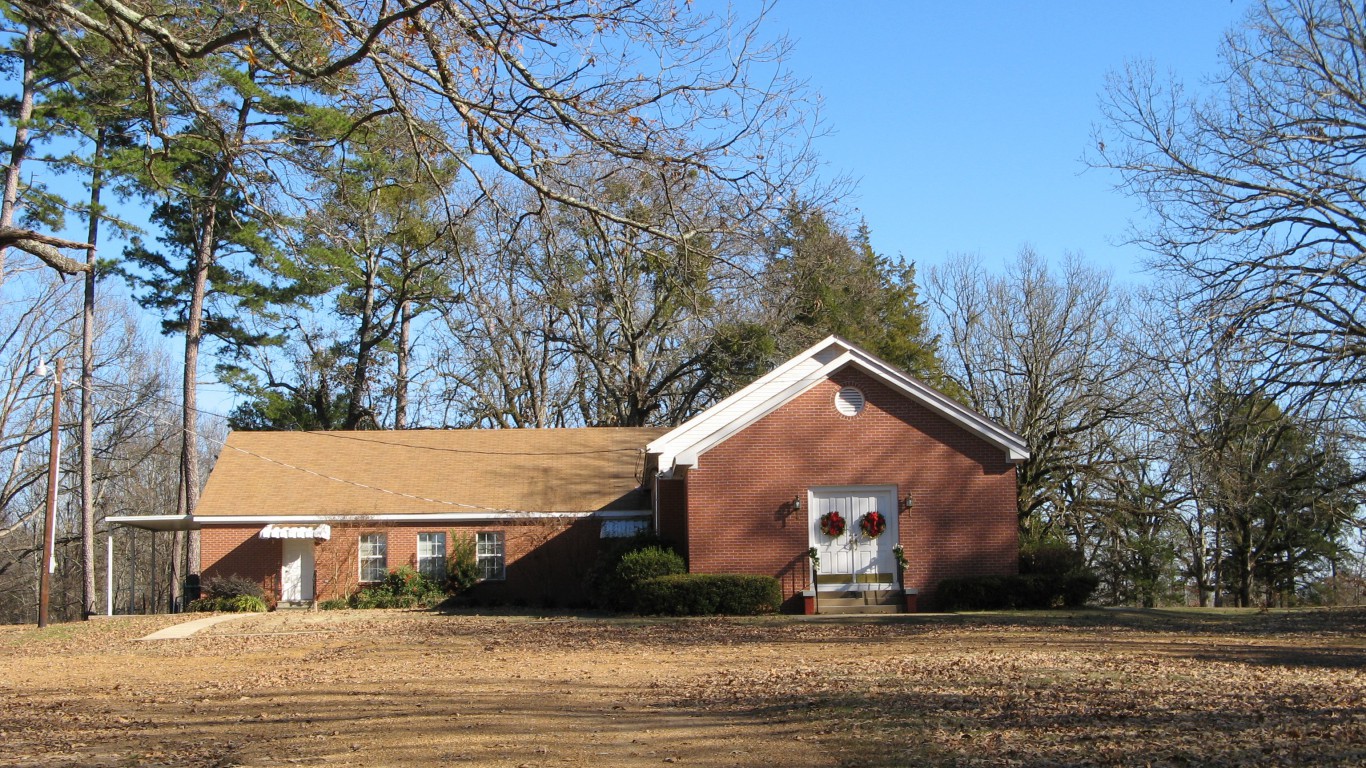
24. Holmes, Mississippi
> County median household income: $20,732
> State median household income: $39,665
> Poverty rate: 43.4%
> Nov. unemployment: 9.3%
Holmes is the poorest county in the poorest state. The typical household earns less than $21,000 a year, the third lowest median household income of any U.S. county. With low incomes, poverty is rampant. Of the 18,800 county residents, approximately 43.4% live in poverty, far higher than the 22.5% statewide poverty rate, itself the highest of all states.
Low incomes are largely the product of poor economic conditions. Jobs in the county are not only low paying, but also hard to find. Nearly one in 10 workers in Holmes are unable to find work, more than double the national unemployment rate and far higher than the 5.2% unemployment rate statewide.
[in-text-ad-2]

25. Mississippi, Missouri
> County median household income: $28,347
> State median household income: $48,173
> Poverty rate: 29.2%
> Nov. unemployment: 5.6%
Mississippi County is the poorest in Missouri and one of the poorest in the nation. The typical household brings in just $28,347 each year, about $20,000 less than the state median income. Home values tend to reflect the earning potential of an area, and Mississippi County, not surprisingly, has extremely inexpensive housing. The typical area home is valued at just $67,700, far less than the state, the nation, and nearly every U.S. county. For reference, the U.S. median home value is $178,600.

26. Glacier, Montana
> County median household income: $29,640
> State median household income: $47,169
> Poverty rate: 33.2%
> Nov. unemployment: 7.7%
Incomes are lower in Glacier than anywhere else in Montana. The typical household earns less than $30,000 annually, and one in three county residents live in poverty. The area is home to the Blackfeet Indian Reservation, one of the largest tribes in the United States. Social and economic disadvantages are very common in Native Americans reservations.
Like many of the poorest counties in other states, Glacier is very rural. Located in northern Montana, with Glacier National Park to the west and Alberta, Canada to the north, there are an average of only 5 people per square mile in the county. In comparison, there are roughly 87 people per square mile nationwide.
[in-text-ad]
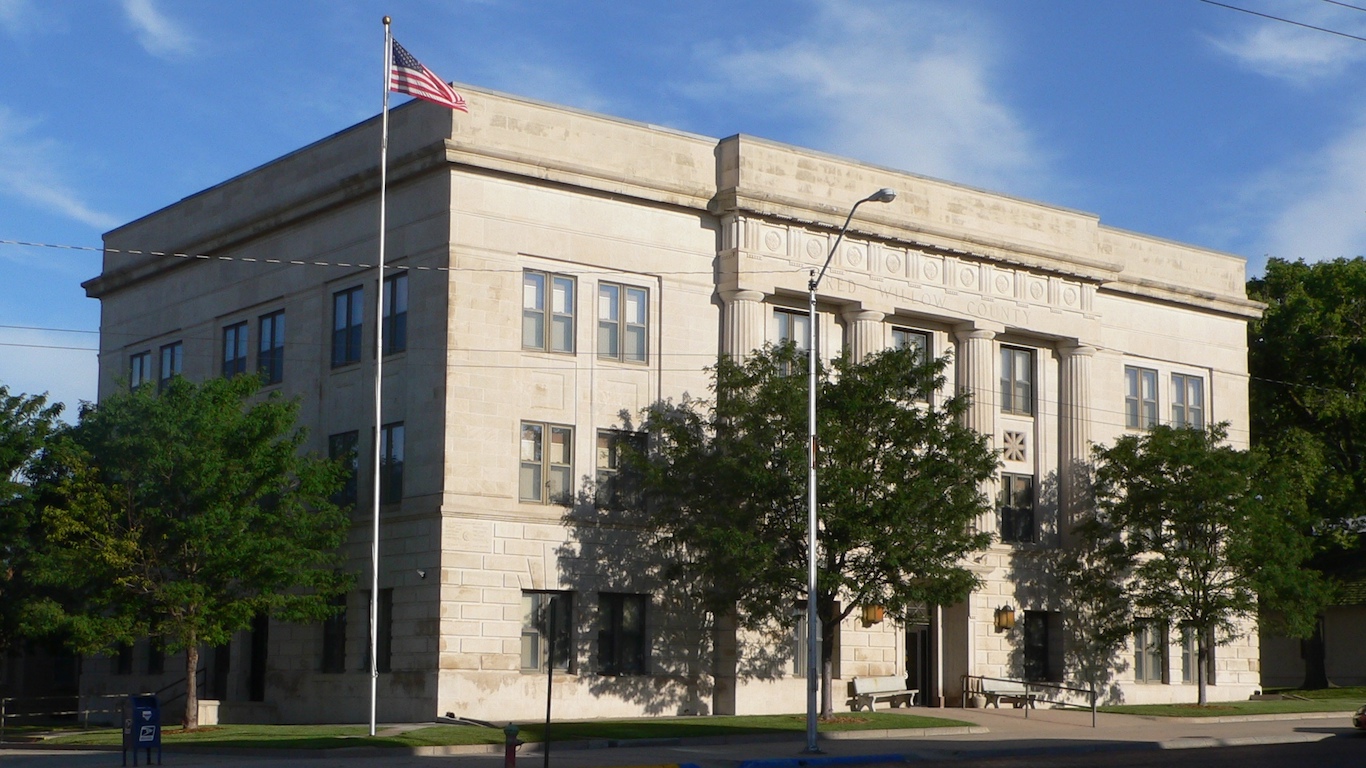
27. Red Willow, Nebraska
> County median household income: $42,931
> State median household income: $52,997
> Poverty rate: 10.6%
> Nov. unemployment: 2.3%
While a low unemployment rate is often an indication of a healthy economy, it is not always indicative of affluence. In Red Willow, only 2.3% of the labor force is out of a job, half the national unemployment rate in November. Due in part to the relative prevalence of jobs, only 10.6% of county residents live in poverty, a smaller poverty rate than both the state and national rates of 12.7% and 15.5%, respectively.
Despite the low unemployment and poverty rates, not many jobs in the county are especially high paying. The typical household in Red Willow earns $42,931 a year, the lowest median income of any county in Nebraska.

28. Nye, Nevada
> County median household income: $41,712
> State median household income: $51,847
> Poverty rate: 18.2%
> Nov. unemployment: 6.6%
The typical household in Nye earns $41,712 annually, about $10,000 less than the typical Nevada household. The presence of relatively few job opportunities may be partially behind the county’s relatively low median income. The area’s 6.6% unemployment rate is higher than both the national and statewide rates of 4.6% and 5.0%, respectively.
Like many of the nation’s low-income areas, the population density in Nye, at an average of only 2 people per square mile, is one of the lowest in the United States.

29. Coos, New Hampshire
> County median household income: $42,312
> State median household income: $66,779
> Poverty rate: 14.1%
> Nov. unemployment: 3.6%
At just 8.9%, New Hampshire’s poverty rate is the lowest of all states. Poverty levels even in the state’s poorest county, Coos, are not nearly as bad as in many other relatively poor areas. Coos’ poverty rate of 14.1% is lower than the national poverty rate of 15.5%. Similarly, only 3.6% of the county’s labor force is out of work, slightly higher than the state’s jobless rate but still well below the national unemployment rate of 4.6%.
[in-text-ad-2]

30. Cumberland, New Jersey
> County median household income: $49,984
> State median household income: $72,093
> Poverty rate: 17.9%
> Nov. unemployment: 6.2%
In Cumberland, the poorest county in New Jersey, the typical household earns approximately $50,000 a year, about $22,000 less than the statewide median income. Higher paying jobs are typically associated with higher educational attainment. In Cumberland, only 14.6% of adults have at least a bachelor’s degree, the smallest share of any New Jersey county.
New Jersey is one of the wealthiest states in the country. So despite Cumberland’s status as the poorest county in the state, it is not especially poor relative to the nation. The typical American household earns only about $4,000 more than the typical Cumberland household.
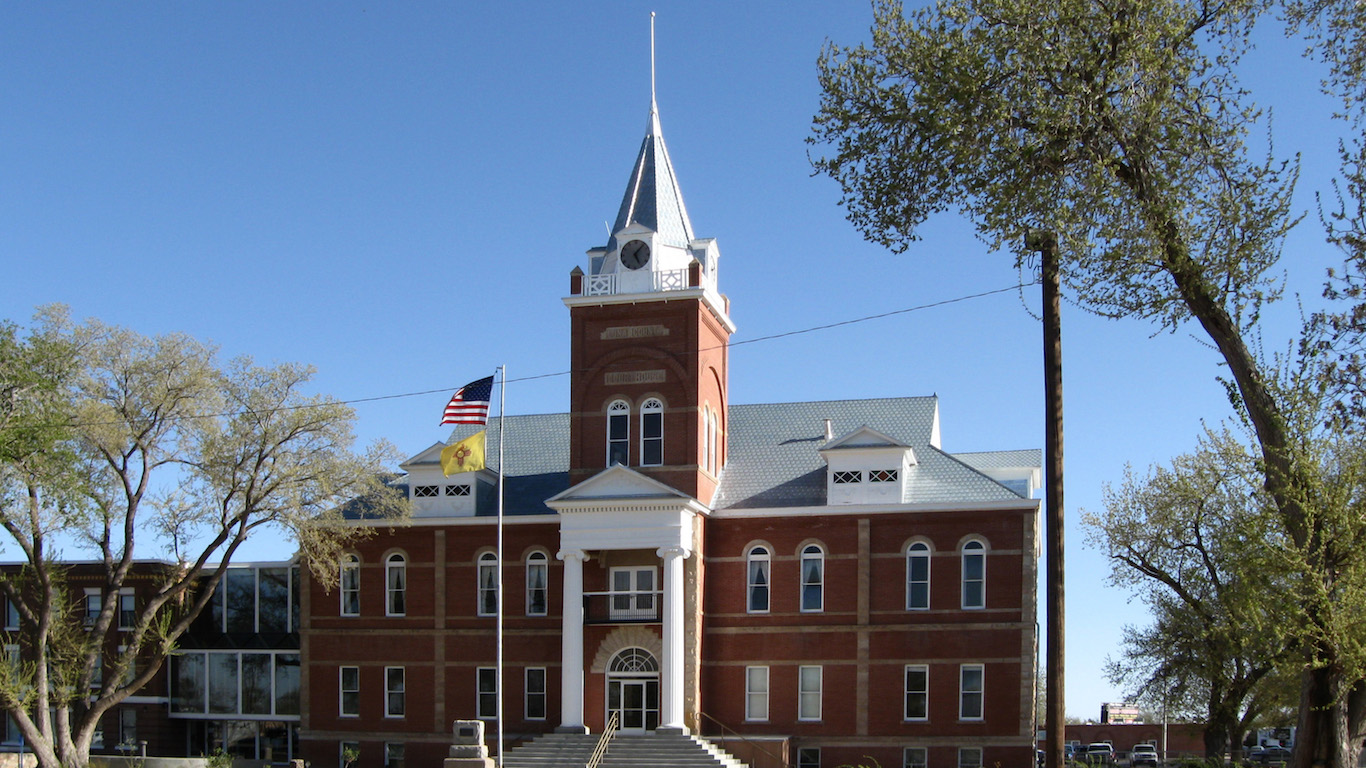
31. Luna, New Mexico
> County median household income: $27,476
> State median household income: $44,963
> Poverty rate: 29.6%
> Nov. unemployment: 15.5%
Luna’s economy is relatively concentrated in agriculture and retail trade, industries in which seasonal employment fluctuations are common. The agricultural, forestry, fishing and hunting, and mining sector employs 8.7% of the county’s workforce, and retail trade employs 13.6%, each higher than the state and national percentages. Even at its lowest point in the year, in September 2016, unemployment in Luna stood at roughly 10% — double the national rate. The relatively difficult job market partially explains low incomes and high poverty in Luna, where the typical household earns just $27,500 a year and nearly 30% of people live in poverty.
[in-text-ad]

32. Bronx, New York
> County median household income: $34,299
> State median household income: $59,269
> Poverty rate: 30.7%
> Nov. unemployment: 7.1%
While New York has a number of poor, rural areas, the poorest county is in one of the state’s urban areas and is surrounded by wealthy counties. The Bronx is less than an hour from the state’s wealthiest counties, including New York County (Manhattan) and Nassau County. Nassau’s median household income of nearly $100,000 a year is almost triple the Bronx’s median household income of $34,299. More than 30% of Bronx residents live in poverty, while Manhattan’s poverty rate is 17.9% and Nassau’s is 6.2%.
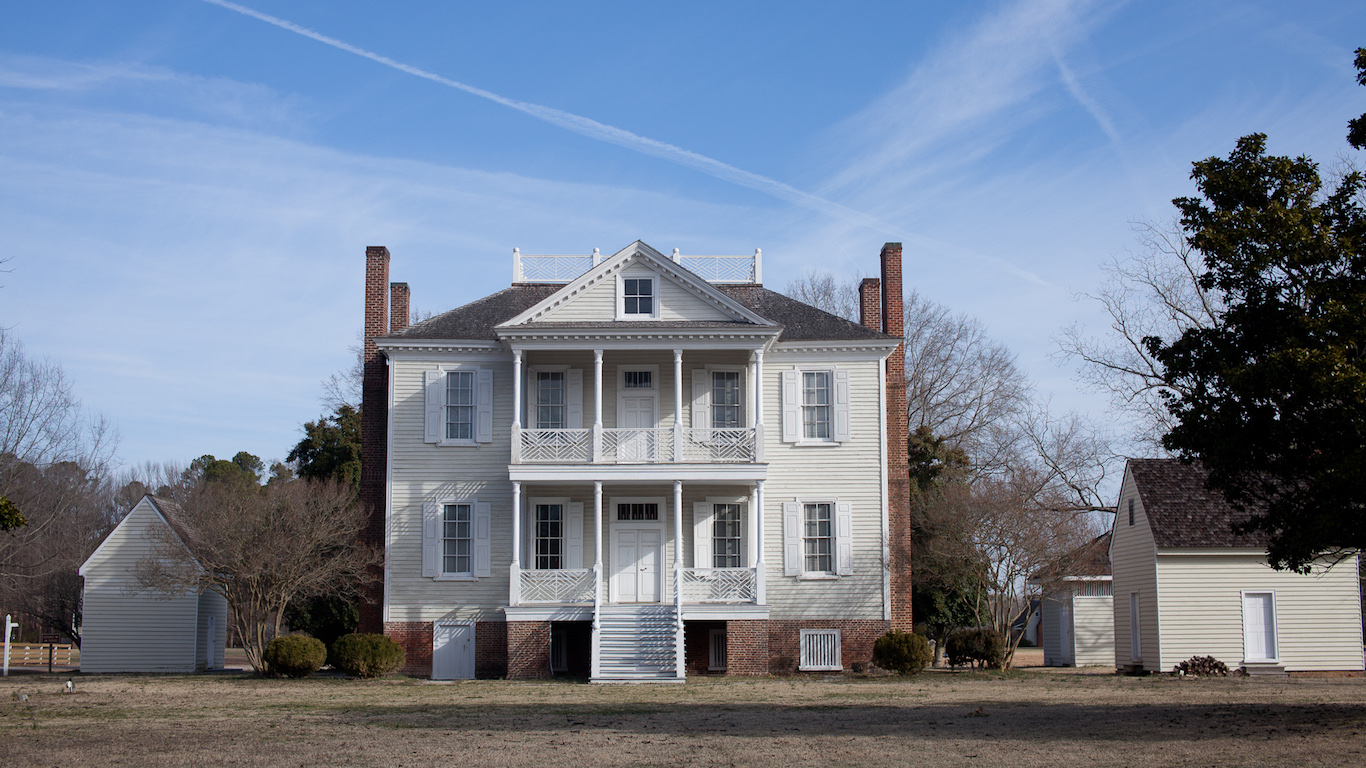
33. Bertie, North Carolina
> County median household income: $30,027
> State median household income: $46,868
> Poverty rate: 22.3%
> Nov. unemployment: 6.0%
Higher educational attainment is often associated with higher incomes. In Bertie, only one in 10 adults have at least a bachelor’s degree, only about a third of the comparable share nationwide. The county’s low educational attainment is a bellwether of low paying jobs. The typical area household earns $30,027 a year, the lowest median income of any county in North Carolina. With lower incomes, poverty is more common in Bertie than it is statewide. More than 22% of county residents live in poverty, about 5 percentage points higher than the statewide poverty rate.

34. Rolette, North Dakota
> County median household income: $33,277
> State median household income: $57,181
> Poverty rate: 35.5%
> Nov. unemployment: 7.1%
The typical household in North Dakota earns $57,181 annually, about $3,300 more than the typical American household. While incomes are relatively high in the state, Rolette is an exception. The typical county household earns only $33,277 annually, the lowest of any county in the state. Many area households earn very low incomes. More than a third of the county’s 14,500 residents live in poverty, more than triple the 11.5% poverty rate statewide.
[in-text-ad-2]

35. Athens, Ohio
> County median household income: $33,872
> State median household income: $49,429
> Poverty rate: 33.0%
> Nov. unemployment: 5.1%
The typical household in Athens County earns $33,872 a year, which is about $58,000 less than the typical income in Delaware County, Ohio’s wealthiest. One in three Athens residents live in poverty, more than double the state’s poverty rate and many times Delaware County’s poverty rate of 4.5%. Homeownership can be common even in very poor areas. In Athens, however, just 56.3% of housing units are owned by their occupants, compared to a statewide homeownership rate of 66.3%.
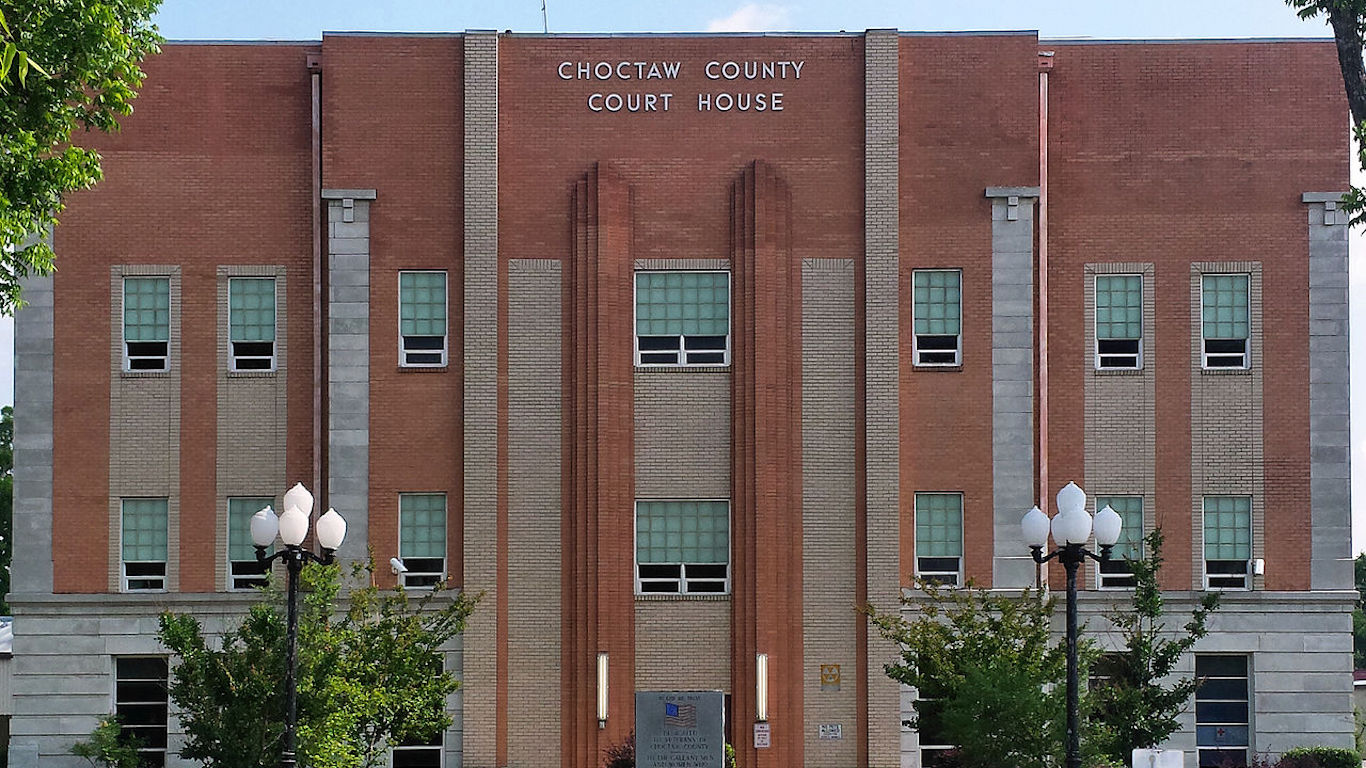
36. Choctaw, Oklahoma
> County median household income: $30,617
> State median household income: $46,879
> Poverty rate: 28.8%
> Nov. unemployment: 8.1%
The typical Choctaw household earns only $30,617 a year, about $16,000 less than the typical Oklahoma household and less than half the median income in Canadian County, the wealthiest in the state. Low incomes are partially the product of a poor job market. Choctaw is one of four counties across Oklahoma where the unemployment rate is higher than 8%. Many of the hundreds of unemployed Choctaw residents are likely also among the 28.8% of people in the county living in poverty.
[in-text-ad]

37. Malheur, Oregon
> County median household income: $35,418
> State median household income: $51,243
> Poverty rate: 25.5%
> Nov. unemployment: 4.8%
Like many low-income areas, Malheur’s population is relatively small, and the county is not densely populated. There are an average of 3 people per square mile in Malheur, versus the population density of 40 people per square mile across the state, and 731 people per square mile in Washington County — Oregon’s richest. Just over one in four Malheur residents live in poverty, well above the state and national rates of 16.5% and 15.5%, respectively.

38. Philadelphia, Pennsylvania
> County median household income: $38,253
> State median household income: $53,599
> Poverty rate: 26.4%
> Nov. unemployment: 6.3%
Many of the poorest counties in each state are far more rural than most counties in the state. As one of the most densely populated and urban counties in the United States, Philadelphia is a notable exception. Despite the benefits of a diverse urban economy, Philadelphia’s median household income of $38,253 is the lowest of any county in Pennsylvania. A low median income is partially the result of high unemployment and a relatively large share of residents are extremely poor. The 6.3% unemployment rate in the county is slightly higher than the 4.9% statewide unemployment rate. Also, the county’s 26.4% poverty rate is far higher than Pennsylvania’s 13.5% poverty rate.

39. Providence, Rhode Island
> County median household income: $49,743
> State median household income: $56,852
> Poverty rate: 17.7%
> Nov. unemployment: 5.0%
Of the five Rhode Island counties with at least 10,000 residents, Providence is the poorest. The county contains the city of Providence as well as residents to the north and west of the city. Rhode Island’s population is relatively small and financially well-off. Even as the poorest county, Providence is not as poor as many other poorest counties in other states. While residents earn much less than residents in Washington County, Rhode Island’s richest area, the income disparity is one of the smallest within states. A typical Washington County household earns $23,000 more a year than the typical Providence household. The average income gap between the poorest and richest counties is approximately $44,000.
[in-text-ad-2]
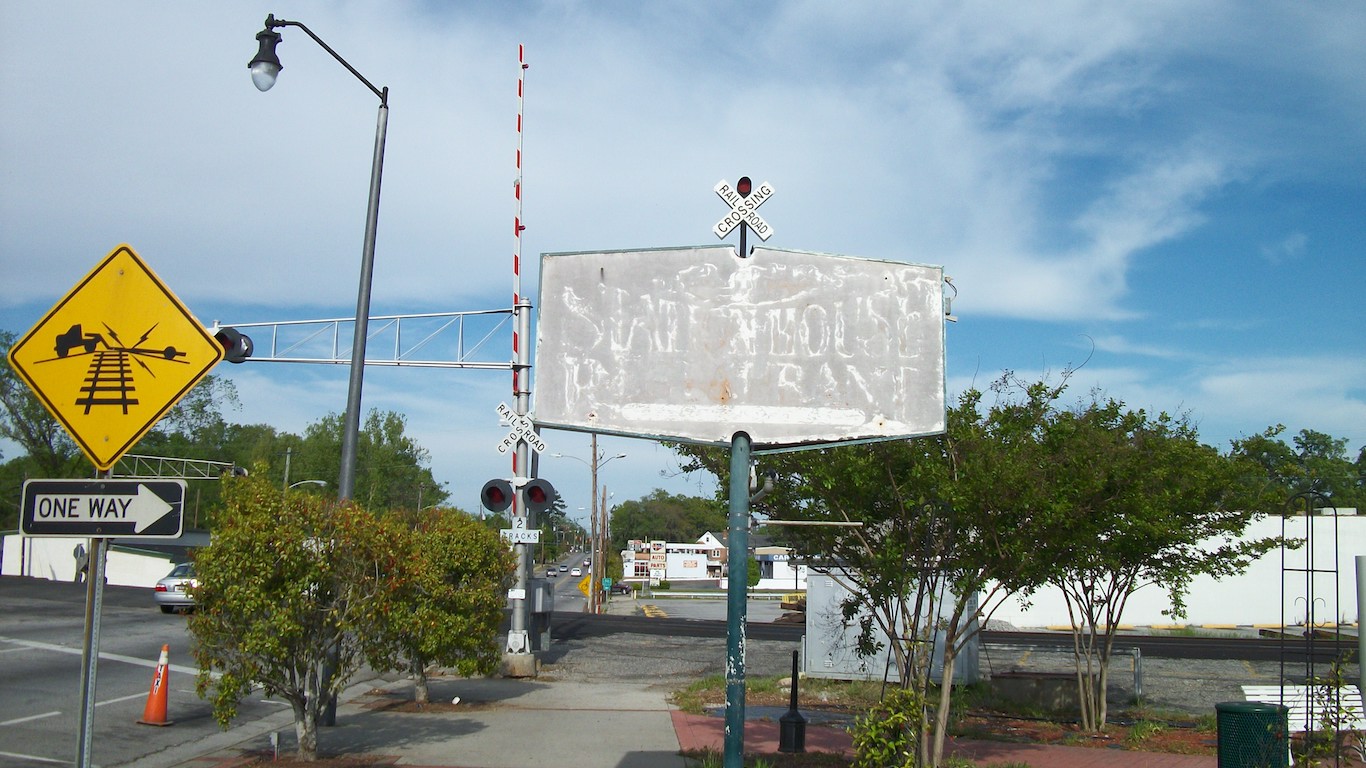
40. Williamsburg, South Carolina
> County median household income: $28,297
> State median household income: $45,483
> Poverty rate: 29.8%
> Nov. unemployment: 5.9%
The median household income in South Carolina is only $45,483 a year, about $8,400 less than the median income nationwide. In Williamsburg, the poorest county in the state, the typical household earns only $28,297 a year. An relatively rural county, job opportunities are few and far between in Williamsburg. The county’s unemployment rate of 5.9% is one of the highest in the state and well above the 4.6% U.S. unemployment rate. Further, because fewer college educated adults suggest fewer high paying jobs, those employed full-time in Williamsburg likely do not earn especially high wages. Only 11.3% of county adults have a bachelor’s degree compared to 29.8% of adults nationwide.

41. Oglala Lakota, South Dakota
> County median household income: $26,369
> State median household income: $50,957
> Poverty rate: 53.3%
> Nov. unemployment: 10.5%
Residents of Native American reservations tend to face social and economic disadvantages far greater than almost anywhere else. These areas often have long histories of hardship. The poorest county in South Dakota, Oglala Lakota, is contained within the Pine Ridge Reservation — and over half of all area residents live in poverty, the highest poverty rate of any U.S. county. The typical county household earns only $26,369 a year, roughly half the income a typical South Dakota household earns annually.
The Pine Ridge Reservation is home to the Wounded Knee Memorial, a commemoration to the 150 Native Americans who were massacred by a federal cavalry regiment in December 1890.
[in-text-ad]
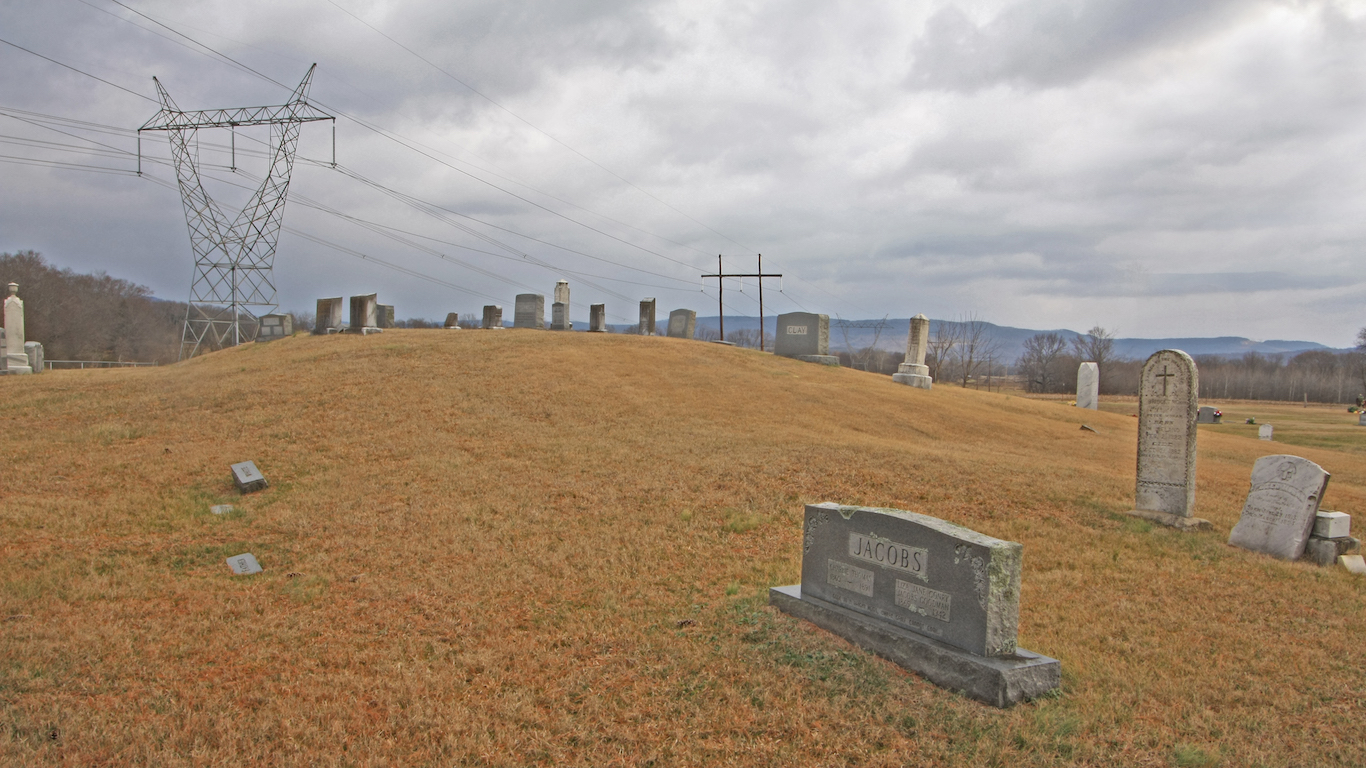
42. Grundy, Tennessee
> County median household income: $27,373
> State median household income: $45,219
> Poverty rate: 28.7%
> Nov. unemployment: 6.9%
With a median household income of $45,219 a year, Tennessee is one of the poorest states. And with a median household income of $27,373 a year, Grundy is not just the poorest county in Tennessee but one of the poorest in the nation. Close to 30% of county resident live in poverty, well above the state poverty rate of 17.6%, itself one of the highest poverty rates among states. By contrast, Tennessee’s richest county, Williamson, has a poverty rate of just 5.1% and the typical household earns nearly $100,000 annually. As is generally the case, Tennessee’s richest county is relatively large, with about 200,000 people, while the state’s poorest county is relatively small, with a population of just 13,524.

43. Starr, Texas
> County median household income: $26,172
> State median household income: $53,207
> Poverty rate: 36.6%
> Nov. unemployment: 12.3%
With a median household income of $26,172 a year, few counties in the United States are as poor as Starr, Texas. The rural county along the Mexican border offers few job opportunities — high-paying and otherwise. Across the county, 12.3% of the labor force is out of a job, nearly triple the 4.2% statewide unemployment rate. Many of the thousands of unemployed area residents are also likely living in poverty. Of Starr’s 63,000 residents, approximately 36.6% live in poverty, a larger share than in all but a few other counties nationwide.

44. San Juan, Utah
> County median household income: $41,484
> State median household income: $60,727
> Poverty rate: 28.1%
> Nov. unemployment: 5.7%
Utah is wealthier than most other U.S. states. Still, not all corners of the state are especially prosperous. In San Juan County, the typical household earns only about $41,500 a year, or about $12,400 less than the typical American household. In San Juan, many people earn very low incomes. The county’s 28.1% poverty rate is more than double Utah’s 12.3% poverty rate.
[in-text-ad-2]

45. Orleans, Vermont
> County median household income: $42,831
> State median household income: $55,176
> Poverty rate: 15.5%
> Nov. unemployment: 4.3%
Orleans has the lowest median household income of any county in Vermont. The county’s 15.5% poverty rate, while higher than the 11.5% statewide rate, is in line with the national poverty level.
Orleans encomposses a remote area known as the Northeast Kingdom bordering Canadian national forest. Unlike in other low-income, relatively rural areas, joblessness is not a major problem for Orleans residents. Only 4.3% of the area’s labor force is out of a job, a slightly smaller share than the 4.6% of unemployed American workers.
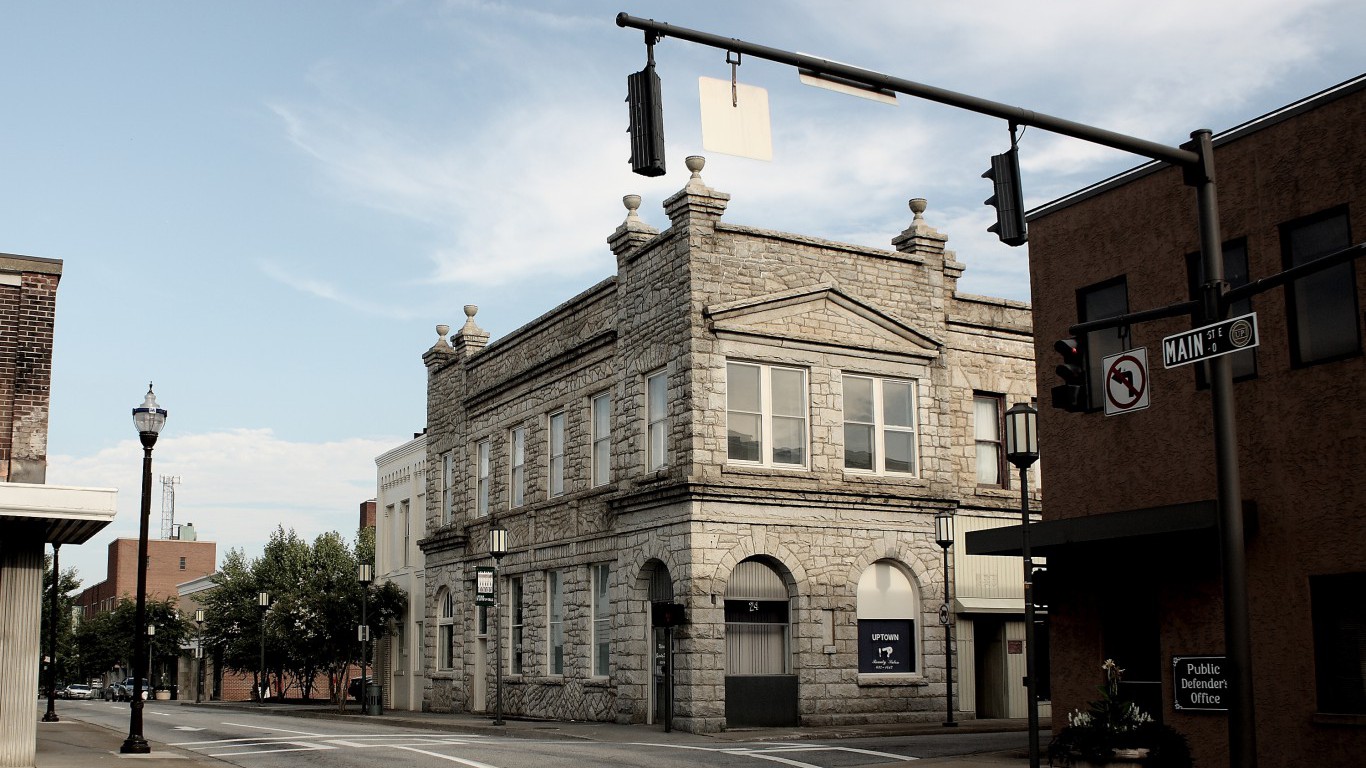
46. Martinsville City, Virginia
> County median household income: $29,587
> State median household income: $65,015
> Poverty rate: 23.6%
> Nov. unemployment: 6.7%
A relatively wealthy state, Virginia’s $65,015 annual median household income is about $11,000 higher than the national median income. Still, not every corner of the state is as prosperous. Martinsville — an independent city and county equivalent — is one of four areas in the state where the median household income is below $30,000 a year.
Nearly 24% of Martinsville residents live in poverty, more than double the statewide poverty rate. The low incomes are partially the result of a relatively weak job market. As of November, 2016, 6.7% of the county’s labor force was out of a job. In comparison, only 4% of Virginia’s workforce was unemployed at that time.
[in-text-ad]
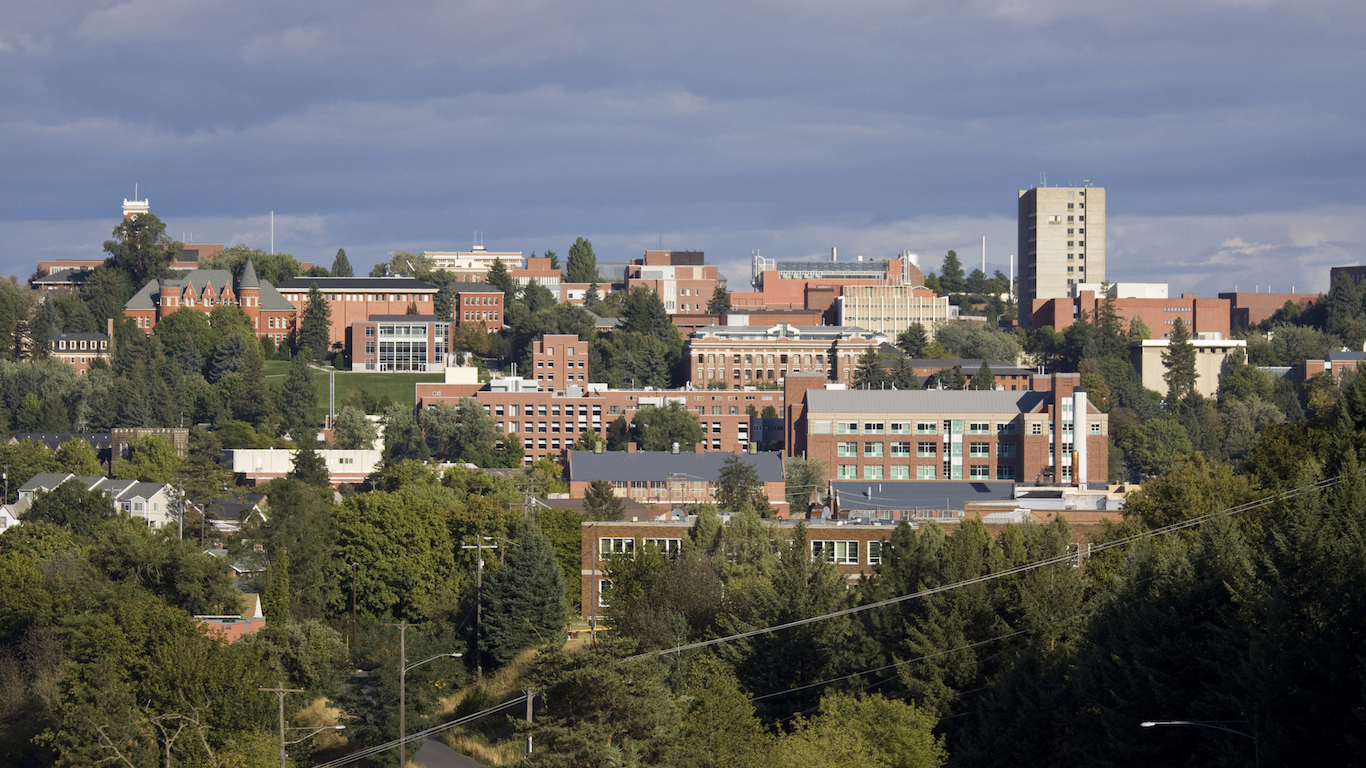
47. Whitman, Washington
> County median household income: $36,631
> State median household income: $61,062
> Poverty rate: 31.2%
> Nov. unemployment: 4.2%
The median household income in Whitman is only $36,631 a year, the lowest of counties in Washington. While incomes are well below what is typical nationwide, home values are higher than they are across the country. The $181,800 median home value in Whitman exceeds the national median home value by over $3,000. The disparity between incomes and real estate values makes homeownership prohibitively expensive for many Whitman residents. As a result, the countywide homeownership rate of 44.5% is among the lowest of any U.S. county.

48. McDowell, West Virginia
> County median household income: $24,921
> State median household income: $41,751
> Poverty rate: 35.5%
> Nov. unemployment: 10.8%
McDowell’s median household income of $24,921 a year is the lowest of any county in West Virginia and one of the lowest nationwide. Well over a third of McDowell’s 20,800 residents live in poverty, and unemployment is relatively common. With more than one in 10 county workers looking for work, the county’s economy ranks among the worst in the United States. Many of the jobs that are available to county residents are likely low skill and low paying as educational attainment rates are some of the lowest in the United States. Only 5.1% of area adults have at least a bachelor’s degree, about one-sixth of the comparable national educational attainment rate.

49. Rusk, Wisconsin
> County median household income: $39,194
> State median household income: $53,357
> Poverty rate: 16.0%
> Nov. unemployment: 4.4%
Rural counties are often poorer than urban counties, and with an average of only 16 people per square mile, Rusk is one of the most rural counties in Wisconsin. The typical household in Rusk earns only $39,194 a year, less than in every other county in the state. Despite relatively low incomes, the area’s poverty rate is similar to the nationwide rate. In Rusk, 16% of residents live below the poverty line, only half a percentage point higher than the national poverty rate.
[in-text-ad-2]

50. Goshen, Wyoming
> County median household income: $42,689
> State median household income: $58,840
> Poverty rate: 17.9%
> Nov. unemployment: 2.7%
Goshen’s median household income of about $42,700 is the lowest of any county in Wyoming. Also, only about 23% of county adults have at least a bachelor’s degree, far less than the 30% of American adults with similar educational attainment.
In the vast majority of states, the poorest county is more sparsely populated than the state as a whole. However, even with only 6 people per square mile, Goshen’s population density matches that of Wyoming, which has the lowest population density in the country after Alaska.
The thought of burdening your family with a financial disaster is most Americans’ nightmare. However, recent studies show that over 100 million Americans still don’t have proper life insurance in the event they pass away.
Life insurance can bring peace of mind – ensuring your loved ones are safeguarded against unforeseen expenses and debts. With premiums often lower than expected and a variety of plans tailored to different life stages and health conditions, securing a policy is more accessible than ever.
A quick, no-obligation quote can provide valuable insight into what’s available and what might best suit your family’s needs. Life insurance is a simple step you can take today to help secure peace of mind for your loved ones tomorrow.
Click here to learn how to get a quote in just a few minutes.
Thank you for reading! Have some feedback for us?
Contact the 24/7 Wall St. editorial team.